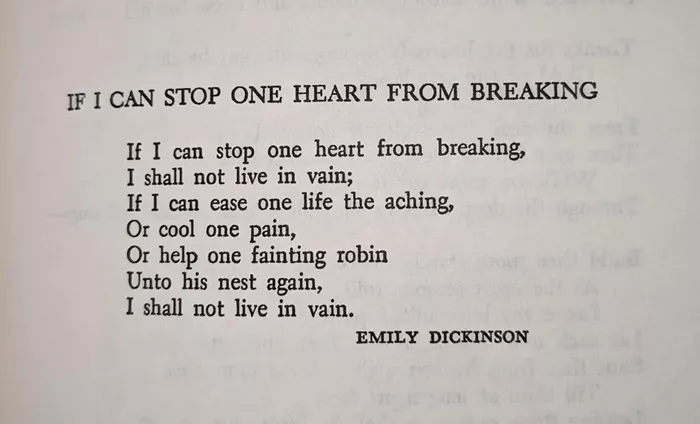Welcome to Poem of the Day – If I Can Stop One Heart From Breaking by Emily Dickinson.
Emily Dickinson is known for her short, poignant poems that often explore themes of nature, love, and human emotions. One of her most famous works, “If I Can Stop One Heart From Breaking,” reflects her deep empathy and selflessness. This poem, though brief, holds a powerful message about kindness and the importance of helping others. In this article, we will break down the meaning of the poem and explore the deeper significance of each line.
If I Can Stop One Heart From Breaking Poem
If I can stop one heart from breaking,
I shall not live in vain;
If I can ease one life the aching,
Or cool one pain,
Or help one fainting robin
Unto his nest again,
I shall not live in vain.
If I Can Stop One Heart From Breaking Explanation
Explanation of the Poem
The poem is composed of six short lines, each contributing to its overall theme of selfless acts. Dickinson, known for her simple and direct style, expresses the value of small, yet meaningful gestures that can make a significant difference in someone’s life.
First Line: “If I can stop one heart from breaking”
The opening line introduces the primary goal of the speaker: to stop one heart from breaking. This suggests an empathetic desire to prevent suffering, to protect others from emotional pain. The use of “one heart” emphasizes that even helping a single person is enough to give purpose to one’s life.
Second Line: “I shall not live in vain”
The second line reflects the speaker’s belief that a life dedicated to helping others is a meaningful life. The phrase “not live in vain” implies that the act of preventing someone from experiencing heartbreak is a worthy purpose that justifies one’s existence.
Third Line: “If I can ease one life the aching”
Here, Dickinson expands the scope of kindness beyond just preventing heartbreak. The speaker desires to relieve emotional or physical suffering (“aching”). This line reinforces the theme of compassion and selflessness, highlighting that alleviating pain in any form is a noble pursuit.
Fourth Line: “Or cool one pain”
This line further extends the idea of helping others by “cooling” pain, another metaphor for easing or soothing someone’s suffering. By using the word “cool,” Dickinson may be suggesting that kindness has the power to bring relief, just as a cool breeze can soothe physical discomfort.
Fifth Line: “Or help one fainting robin”
The next line introduces a more specific example of compassion – helping a “fainting robin.” The image of a fragile bird in need of assistance symbolizes vulnerability. By choosing a robin, a small, helpless creature, Dickinson emphasizes the idea that even small, seemingly insignificant acts of kindness can have great meaning.
Sixth Line: “Unto his nest again”
The final line suggests that the act of helping the robin is not just a temporary fix, but one that allows the bird to return to its home. This return to safety and comfort parallels the emotional healing that the speaker seeks to provide to others. It completes the picture of a life lived with purpose—one that nurtures and restores.
Themes and Interpretation
The overarching theme of “If I Can Stop One Heart From Breaking” is the importance of selflessness and the value of small acts of kindness. The speaker expresses that life gains meaning not from grand accomplishments or fame, but from the ability to ease the suffering of others. By helping just one individual, whether human or animal, the speaker believes that their life will have been worthwhile.
The poem also touches on the idea of empathy. Dickinson’s speaker is not concerned with personal gain or recognition; their focus is on the well-being of others. The act of helping is not about receiving something in return but about fulfilling a sense of moral duty.
Conclusion
In “If I Can Stop One Heart From Breaking,” Emily Dickinson captures the essence of human compassion in its purest form. The poem encourages readers to reflect on the significance of small acts of kindness and how they can make a lasting impact. In a world where the scale of problems can often seem overwhelming, Dickinson’s words remind us that even the smallest gestures of empathy and care are valuable and worthy of recognition. In the end, it is not about changing the world on a grand scale, but about touching lives in meaningful ways, no matter how simple they may seem.

